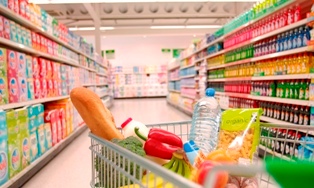Where you are paying more for food: Joburg vs Cape Town vs Durban
The latest food price data from the Pietermaritzburg Economic Justice & Dignity group (PMBEJD) shows that outlying and remote areas in South Africa still carry the highest prices for food baskets – while among the major metros, Joburg prices are higher.

Staff Writer | Business Tech
The civil society initiative found that its household food basket recorded a slight increase in price month-on-month, and remains at much higher levels than September 2020, when the basket was first compiled.
The basket was tracked at R9.20 (0.2%) more expensive than a month ago (June) at R4,137.43. Over the past 11 months, the cost of the average basket price increased by 7.3% or R281. Inflation over the same period was much lower, tracking between 3% and 5%.
The basket comprises 44 core food items most frequently purchased by lower-income households who make up the majority of households in the country.
Since September 2020, the PMBEJD tracks food prices in three major metropolitan areas – Johannesburg, Cape Town and Durban – as well as two more remote or secondary metro regions – Pietermaritzburg and Springbok – to get a better sense of how prices differ across the country.
The cost difference of the total household food basket in the main metros of Joburg, Durban and Cape Town is consistent at around ±R200, the group noted.
Springbok and Pietermaritzburg tend to be outliers in the data, with Springbok (in the Northern Cape) being highest, and Pietermaritzburg, lowest.
Over the last 11 months, Springbok has also seen the largest increase in food prices overall – 11%. Cape Town has seen the lowest price inflation at about 4.3%.
 https://businesstech.co.za/news/wp-content/uploads/2021/07/July-food-prices-by-area-300x94.png 300w, https://businesstech.co.za/news/wp-content/uploads/2021/07/July-food-prices-by-area-1024x321.png 1024w, https://businesstech.co.za/news/wp-content/uploads/2021/07/July-food-prices-by-area-768x241.png 768w, https://businesstech.co.za/news/wp-content/uploads/2021/07/July-food-prices-by-area-1200x376.png 1200w" alt="" width="1009" height="316" class="aligncenter wp-image-510036 lazyloaded" style="border: 0px; vertical-align: middle; max-width: 100%; transition: opacity 0.3s ease 0s; clear: both; opacity: 1; height: auto; margin: 0px auto; display: block; backface-visibility: hidden;" data-aspectratio="1009/316" data-src="https://businesstech.co.za/news/wp-content/uploads/2021/07/July-food-prices-by-area.png" data-srcset="https://businesstech.co.za/news/wp-content/uploads/2021/07/July-food-prices-by-area.png 1404w, https://businesstech.co.za/news/wp-content/uploads/2021/07/July-food-prices-by-area-300x94.png 300w, https://businesstech.co.za/news/wp-content/uploads/2021/07/July-food-prices-by-area-1024x321.png 1024w, https://businesstech.co.za/news/wp-content/uploads/2021/07/July-food-prices-by-area-768x241.png 768w, https://businesstech.co.za/news/wp-content/uploads/2021/07/July-food-prices-by-area-1200x376.png 1200w" />
https://businesstech.co.za/news/wp-content/uploads/2021/07/July-food-prices-by-area-300x94.png 300w, https://businesstech.co.za/news/wp-content/uploads/2021/07/July-food-prices-by-area-1024x321.png 1024w, https://businesstech.co.za/news/wp-content/uploads/2021/07/July-food-prices-by-area-768x241.png 768w, https://businesstech.co.za/news/wp-content/uploads/2021/07/July-food-prices-by-area-1200x376.png 1200w" alt="" width="1009" height="316" class="aligncenter wp-image-510036 lazyloaded" style="border: 0px; vertical-align: middle; max-width: 100%; transition: opacity 0.3s ease 0s; clear: both; opacity: 1; height: auto; margin: 0px auto; display: block; backface-visibility: hidden;" data-aspectratio="1009/316" data-src="https://businesstech.co.za/news/wp-content/uploads/2021/07/July-food-prices-by-area.png" data-srcset="https://businesstech.co.za/news/wp-content/uploads/2021/07/July-food-prices-by-area.png 1404w, https://businesstech.co.za/news/wp-content/uploads/2021/07/July-food-prices-by-area-300x94.png 300w, https://businesstech.co.za/news/wp-content/uploads/2021/07/July-food-prices-by-area-1024x321.png 1024w, https://businesstech.co.za/news/wp-content/uploads/2021/07/July-food-prices-by-area-768x241.png 768w, https://businesstech.co.za/news/wp-content/uploads/2021/07/July-food-prices-by-area-1200x376.png 1200w" />
This indicates that life is particularly difficult for households who live in more remote areas outside the major metros, where securing food items can be more costly due to the logistics in distributing products.
These circumstances would have been exacerbated in places like Pietermarizburg in the past month, due to transport issues during and after the July riots.
Overall, the price of maize meal, rice, flour, and white sugar declined in July. Cooking oil prices continued to be high, and potato, onion, and butternut prices increased – as did frozen chicken portions, eggs, and most meats. Bread prices increased marginally.
Of the 44 food items tracked by the group 21 increased in price, while 18 dropped in price month-on-month.
While these changes tracked across the areas assessed by the PMBEJD, many of the price increases were more pronounced in Cape Town, which saw some vegetables like butternut increase by 35%.
Springbok also saw some significant price hikes, with chicken livers shooting up 80%, while the price of cabbage went up 44%.
 https://businesstech.co.za/news/wp-content/uploads/2021/07/Food-prices-July-DvJvC-243x300.png 243w, https://businesstech.co.za/news/wp-content/uploads/2021/07/Food-prices-July-DvJvC-829x1024.png 829w, https://businesstech.co.za/news/wp-content/uploads/2021/07/Food-prices-July-DvJvC-768x949.png 768w" alt="" width="996" height="1231" class="aligncenter size-full wp-image-510034 lazyloaded" style="border: 0px; vertical-align: middle; max-width: 100%; transition: opacity 0.3s ease 0s; clear: both; opacity: 1; height: auto; margin: 0px auto; display: block; backface-visibility: hidden;" data-aspectratio="996/1231" data-src="https://businesstech.co.za/news/wp-content/uploads/2021/07/Food-prices-July-DvJvC.png" data-srcset="https://businesstech.co.za/news/wp-content/uploads/2021/07/Food-prices-July-DvJvC.png 996w, https://businesstech.co.za/news/wp-content/uploads/2021/07/Food-prices-July-DvJvC-243x300.png 243w, https://businesstech.co.za/news/wp-content/uploads/2021/07/Food-prices-July-DvJvC-829x1024.png 829w, https://businesstech.co.za/news/wp-content/uploads/2021/07/Food-prices-July-DvJvC-768x949.png 768w" />
https://businesstech.co.za/news/wp-content/uploads/2021/07/Food-prices-July-DvJvC-243x300.png 243w, https://businesstech.co.za/news/wp-content/uploads/2021/07/Food-prices-July-DvJvC-829x1024.png 829w, https://businesstech.co.za/news/wp-content/uploads/2021/07/Food-prices-July-DvJvC-768x949.png 768w" alt="" width="996" height="1231" class="aligncenter size-full wp-image-510034 lazyloaded" style="border: 0px; vertical-align: middle; max-width: 100%; transition: opacity 0.3s ease 0s; clear: both; opacity: 1; height: auto; margin: 0px auto; display: block; backface-visibility: hidden;" data-aspectratio="996/1231" data-src="https://businesstech.co.za/news/wp-content/uploads/2021/07/Food-prices-July-DvJvC.png" data-srcset="https://businesstech.co.za/news/wp-content/uploads/2021/07/Food-prices-July-DvJvC.png 996w, https://businesstech.co.za/news/wp-content/uploads/2021/07/Food-prices-July-DvJvC-243x300.png 243w, https://businesstech.co.za/news/wp-content/uploads/2021/07/Food-prices-July-DvJvC-829x1024.png 829w, https://businesstech.co.za/news/wp-content/uploads/2021/07/Food-prices-July-DvJvC-768x949.png 768w" />
Statistics South Africa’s Consumer Price Index for Food and Non-alcoholic Beverages was unchanged at 6.7% in June 2021. Headline inflation for this same period is 4.9%.
“The value of the money we have in our pockets is being eroded by higher levels of inflation on basic goods and services viz. food, electricity, and transport. High inflation levels on food are especially harmful to households living on low incomes as families spend a much higher proportion of their income on food,” the PMBEJD said.
The National Minimum Wage for a General Worker in July 2021 is R3,817.44. Transport to work and back will cost a worker an average of R1,320 (34.6% of NMW), and electricity an average of R731.50 (19.2% of NMW).
“Together, transport and electricity – both non-negotiable expenses – take up 53.7% (R2,051.50) of the NMW, leaving R1,765.94 to secure all other household expenses.
“The average cost of the PMBEJD Basic Nutritional Food Basket for a family of four persons in July 2021 is R2,837.70. On this data, if all the remaining money after transport and electricity went to food, families will still have a food shortfall of 37.8% (-R1,071.76),” it said.
News Category
- International retailers
- On the move
- Awards and achievements
- Legislation
- Wine and liquor
- Africa
- Going green
- Supplier news
- Research tools
- Retailer trading results
- Supply chain
- Innovation and technology
- Economic factors
- Crime and security
- Store Openings
- Marketing and Promotions
- Social Responsibility
- Brand Press Office
Related Articles

Empowering South African households through gro...

SPAR shares practical tips to beat food inflation

South African motorists could be paying up to R...

Big VAT changes on the cards


